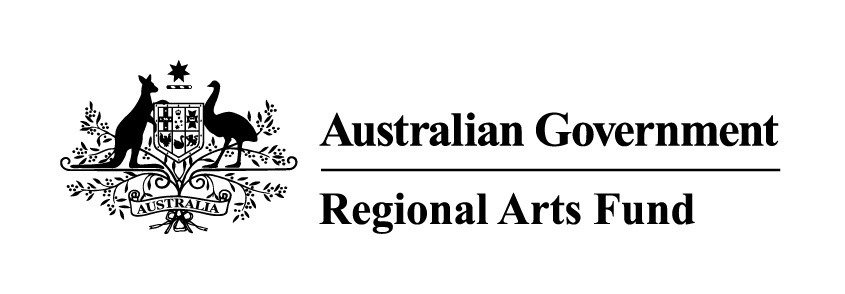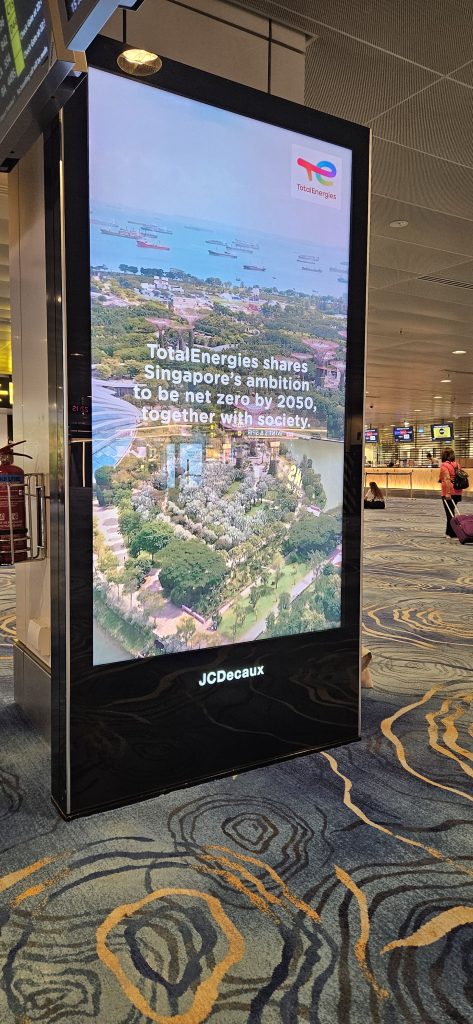On 18 July 2024, I co-convened “Planetary Data Infrastructures,” with peers selecting a satisfying series of workshops and participatory sessions integrating scholarly presentations with skills sharing and artistic practice through embodied knowledge transmission at the “Making and Doing Transformations” symposium hosted by the Athena Institute in Amsterdam as part of the 11th quadrennial joint global conference of EASST-4S. Amid an expert community, alongside the fantastic talks and multiple resonances with other colleagues, that left me spinning for weeks after—the insights I’m still unravelling.
At this I specifically presented “Decolonising Digital Culturescapes, Permacomputing from an Antipodean Perspective”. And was fortunate to be assisted by Regional Arts Fund Tasmania, made possible by the Australian Government, which supports the arts in regional and remote Australia, the grant enabled me to travel and share artistic research alongside respected colleagues from all over the globe engaged in maker culture that intersects with the transdisciplinary field of Science, Technology, and Society Studies at EASST-4S.
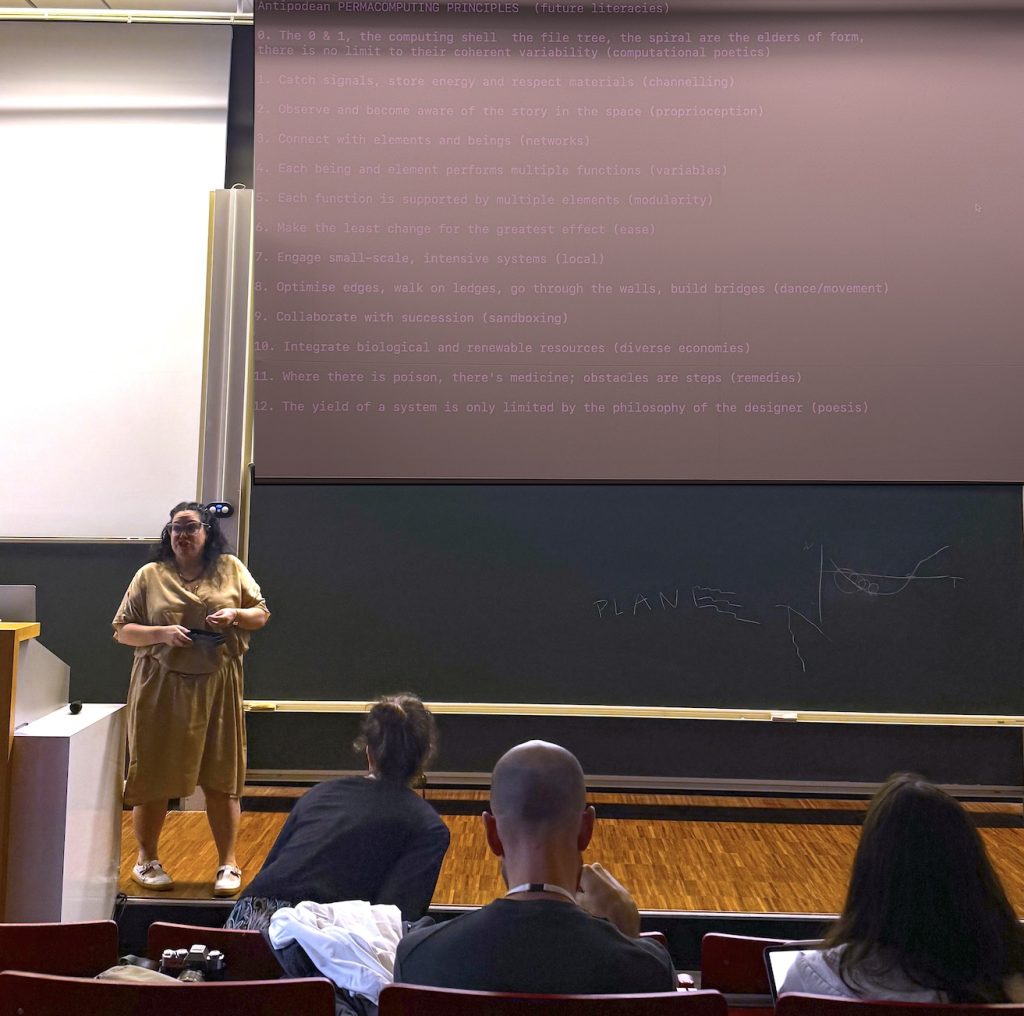 Decolonising Digital Culturescapes, Permacomputing from an Antipodean Perspective. Image by Juan Fortun
Decolonising Digital Culturescapes, Permacomputing from an Antipodean Perspective. Image by Juan Fortun
I discussed a developing set of antipodean or southern Permacomputing principles, which I aim to seek broader input from the wider community, when they’re a bit more refined. They may might fork for another perspective, change around, add to them, give constructive critique etc.
The intention with Permacomputing Principles is that they’re a distilled and persuasive way to begin to cocreate new pathways with entities to restore damaged and/or ignite neglected customs that nuture how to be aware of the mirco worlds, that come with being able to reading the different nuances of the space that you are stand. Through hands on processes, one gains experiential knowledge and literacy to discern the tacit nature of caretaking in place-based contexts. These collective knowledge processes could be thought of as heritage algorithms and patterns that weave dynamic relations. Not readily demonstrated by rote learning, or stock standard prescriptions, nor are they found on a didactic cardboard cut-out to direct you the right way to roam or move for heightened sensemaking. The pertinence of which will return in a more transversal way in this particular report.
I’ve been exploring everyday holistic computing practices and the spatial and environmental dimensions (such as the carbon footprint associated with an email or the perils of sharing artwork on Instagram). These elements occupy the concerns of artists and designers in various ways and manifest through different techniques. I’m particularly fascinated in how codework and computing arts can exude the innovative landscape of the Southern Oceanic region.
In this small report I’m focusing on what unfolded and what I noticed incidentally, as part of the long and rare journey to the Northern Hemisphere, after not visiting Amsterdam for eight years, many things were quite vivid to me as when I lived there (1998 to 2008), much of this time prior to formally being a part of the ‘euro area’ (I will avoid a nostalgic rant, but must say it was a fortunate time where a vibrant informal economy of experimental art and related subcultures flourished).
Like all good journeys, mine began a few days before I physically departed the southern hemisphere and it continued to flow into following days after landing back home, in serendipitous ways.
As someone who values the nature of improvisation and the curious ways that unintended consequences can provide. This includes an eagle eye point of view or an omen to ruminate upon. These insights are gained through awareness nurtured in reading the space around you, which is often fostered in theatre and dance devising, development and rehearsals where your encouraged to refine your haptic knowledge of the space in relation to other entities often in durational settings, this is the case for some experiential maker subcultures where potent informal exchange emerges dynamically.
Put simply, tacit knowledge sharing and related forms of learning are tactics which are often hard to measure, control and scale, they are so much more than a prescribed set of regimes that were most likely developed in alien and unrelated contexts.
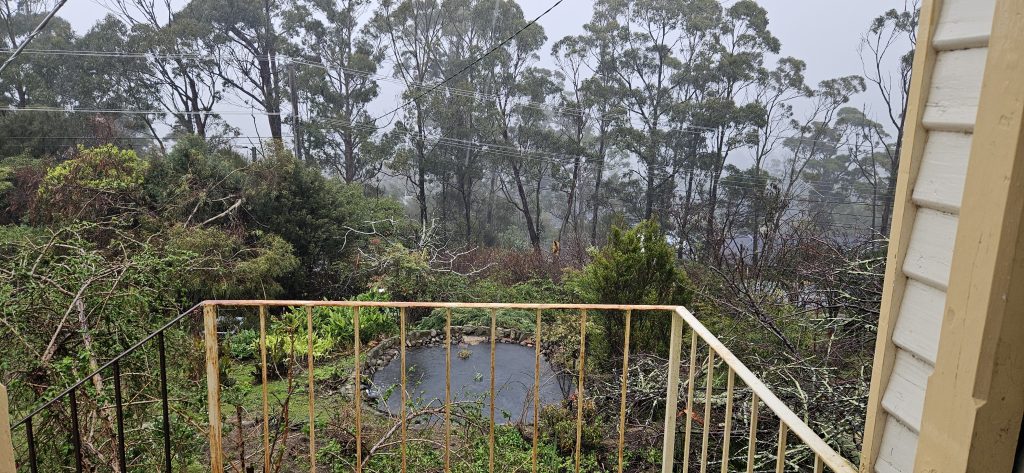 Home pond. 42°58’35.2″S 147°19’39.6″E
Home pond. 42°58’35.2″S 147°19’39.6″E
Before I departed it was cold and wet. I ruminated on my pond as a kind of ledger for flourishing entities. I trusted this body of water could transmitted undetected knowledge to me for when I may need to draw upon it. As I’ll be in new social systems as a guest at the whim of my hosts, I confided in the pond and asked it for protection.
To try out the rare guest role, that I don’t occupy very often lately. Two days before my flight to the Northern Hemisphere I attended a friend’s 50th birthday party.
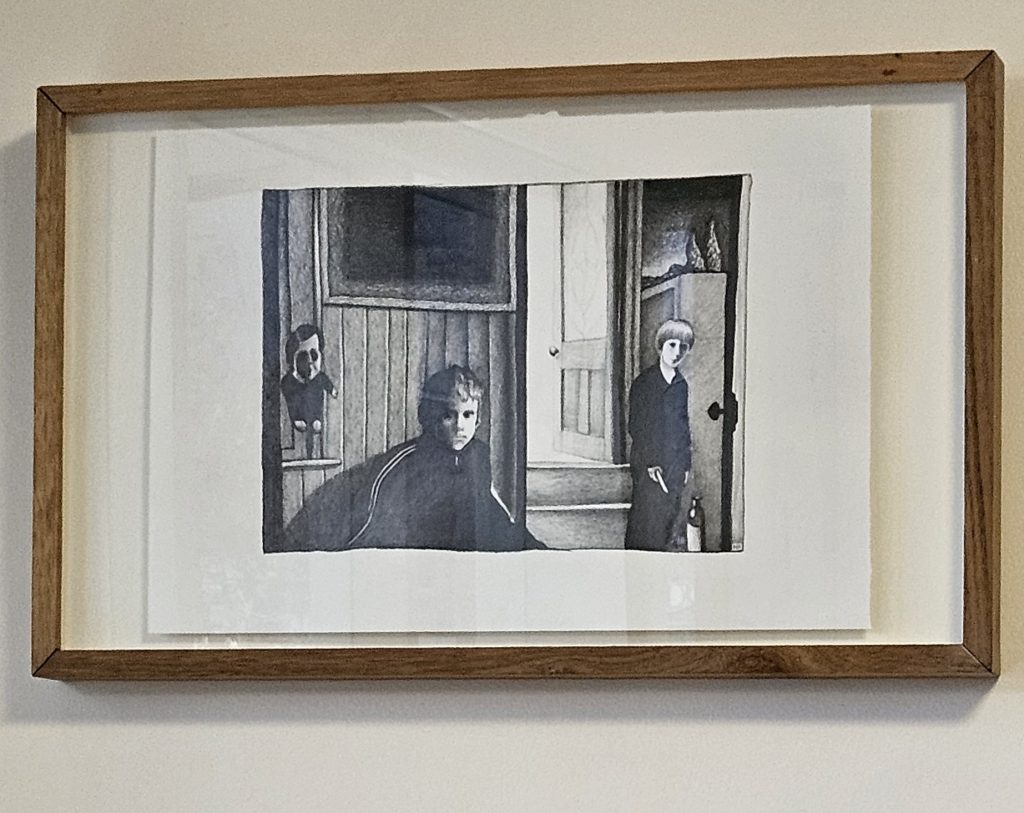 Nicholas Smithies and Daniel Young in 1984, Drawing by Natalie Holtsbaum (2024).
Nicholas Smithies and Daniel Young in 1984, Drawing by Natalie Holtsbaum (2024).
Our gift was a drawing of a photographic image brought back to life through the artistry and handiwork of Natalie Holtsbaum an artist, designer and master goldsmith by trade. I hadn’t realised the other character in the photo was Dan until it was on his kitchen wall. Even though I gazed at on the wall of my various houses now and then for the past 14 years.
On entering the home, I was struck by a compelling image of a Zen Buddhist formed by shiny stickers that rested in the wall opposite the front door, greeting me. The work was by Dan’s late mother, Karen Casey (1956–2021) an artist and Palawa woman. I ruminated with this Zen hell pop contradiction that evening. Calming my nerves about the flight and consoling myself with the fact that I’d previously made a commitment to myself not to travel any longer. It became salient that this trip was wasn’t really about me at the centre, of this decision. We are not the measure of our actions entirely. It’s important to decenter the human self from taking up all the frame.
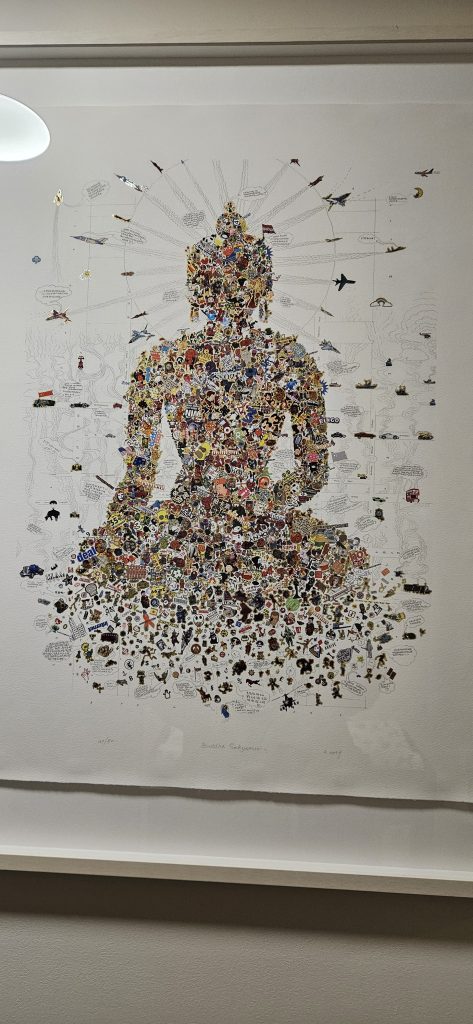
Karen Casey (year TBC) Title TBC. An image of a mediation pose formed by shiny stickers.
At the party, there was a magnificent spread of food, delightful company, great music and a firepit. I stood by its warm embers, and began talking to Elder Uncle Jim Everett / Puralia Meenamatta. The evening before, he was awarded Aborigine of the Year at the NAIDOC Ball in Nipaluna (Hobart). Not that he mentioned that. Too humble. We talked about where we grew up and lived and shared our experiences in these places.
Uncle Jim doesn’t recognise the “colonial” court laws as sovereignty was never ceded: ”I’m not an Australian citizen. I am the plangermairreenner of the Turbuna people of Tasmania. I maintain myself as a sovereign citizen because they’ve never asked us to be citizens. There is no form of documentation or Treaty ever undertaken in this country.”
I appreciate this sentiment that I first heard recently when arrested while protesting for protecting the native forest in Styx Valley, his responsibility as a custodian. This form of protest isn’t new, many of us who grew up on this island were involved with many people from around the world who came to show solidarity in the eight-year-long ‘Franklin campaign’ A successful example of impactful and inspiring of non-violent direct action to bring about lasting change.
The meeting was timely because the occasion allowed me to informally discuss with Uncle Jim’s his take on Permaculture, a process seeded from in Indigenous Knowledge Systems (IKS), that circulate amongst respected custodians in what’s now called Tasmania. He spoke of how he met Mollison when they were both seamen and told that he also worked with his mother. There was no animosity. It is important to note recently there are erroneous claims that “Bill Mollison stole this knowledge from the Aboriginal Tasmanian people. He learned their way of life by living with them”, this is articulated in Fresh Banana Leaves by Jessica Hernandez. The uninformed nature of academic polemics wrapped in benevolence might do more harm than good. I’m not sure if these are consciously planned but they can emerge from confusions and conflated imaginaries of a vast disconnected population. Notably, I am still conducting formal research which is ongoing and in process of being guided by gratitude, respect, and awareness.
As someone who has grown up on the island for at least four generations the conviction that a more local and agreed upon view is that in the 1970s Mollison researched and published extensive genealogies of Tasmanian Aborigines, enabling many First Nations peoples to prove their lineage, and assisting the emergence of the Tasmanian Aboriginal movement As the father of permaculture,’ a common parlance attributed to Mollison who credits IKS with compelling his model in the seminal book ‘Permaculture: A Designers’ Manual'” stating a call to arms to
adopt sophisticated aboriginal belief systems and learn respect for all life, then we lose our own
. A few decades ago Mollison wrote, “The greatest change we need to make is from consumption to production, even if on a small scale, in our own gardens. If only 10 per cent of us do this, there is enough for everyone.”
This informal chat was remarkable with Uncle Jim who advised that Permaculture will only work if everyone is committed to the process. This wisdom is something worth implementing. While it’s not the place to develop this further. What is pertinent to this particular report I write is the Tasmanian provenance of permacomputing, a derivative of permaculture. The state should not remove people from their processes with organisms and expect either to survive. Especially at the moment the island can position itself as a global beacon to reduce greenhouse gas emissions, its reputation as a social leader in climate action is in jeopardy. The state’s ministry faces urgent challenges: a failure to adopt best policymaking practices, a lack of digital accountability, etc. Yet, Internet-powered governance tools offer advanced solutions to collectively and holistically address complex socio-economic issues, providing valuable insights into decision-making processes, enabling robust community connections, and shaping new political realities. Effectuating the potential of community led prosperous societies. As humankind acts to combat climate catastrophe, the need to rapidly transform techno-socio-cultural-political practices to align with digital frontiers and asymmetrical mercantile investment strategies by anachronistic authoritarianism. By adopting co-designed governance practices for adaptive infrastructure could grant Elders and custodians of Tasmania to finally establish Treaty and which by very nature of heritage patterns in Indigenous knowledge Systems already equipped to lead the application of alignment with the UN SDGs and the Closing the Gap Plan, which entails transformations and sacrifice in regards to consumption habits. Of course, there’s quite a lot of nuances left out of this overview. What can be aforesaid, for now, is small-scale systems prevent exploitation and accumulation of knowledge economies from colonial institutions, embedded protocols that eradicate the customs, relations and vessels (materials, objects, elements from the island) that channel and hold awareness of energies and entities that can flourish and flow through and from us through frequencies, signals, loops and weaves.
One example of this glut was gleaned from transit in Singapore, I was struck by the Greenwashing propaganda. An arsenal charming connectivity boasting efficiency in industrial systems, financial instruments and assumption obey. An arsenal of charming connectivity boasting efficiency in industrial systems, financial instruments and assumption obey.

Hideous life-size cardboard cutouts of policewomen warned of 7 years in jail for shoplifting in the Chanel section of the duty-free—amongst the entire transit environment, it was my hunch, that almost no one could probably afford anything on offer in the shop labels featuring Tiffany, Hermes and the usual parade of luxury, abhorrence.
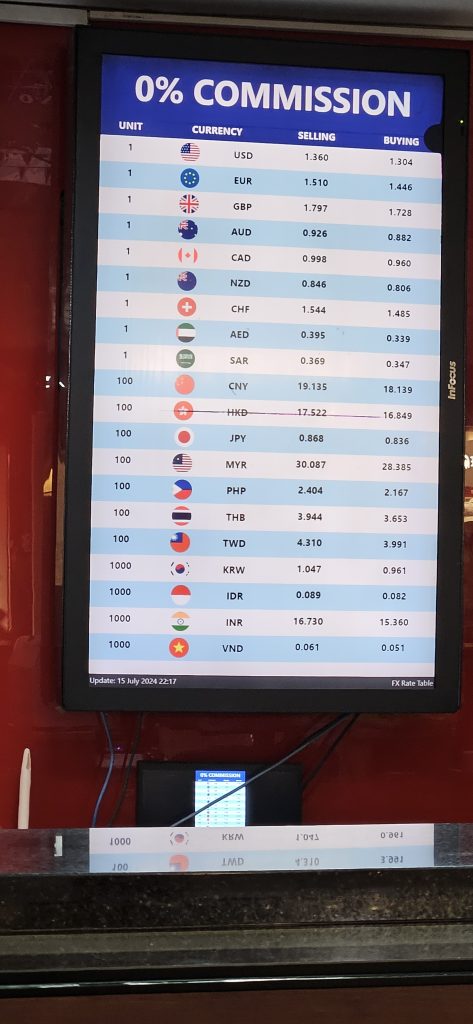 Whats more in this airport, the currency of Hong Kong was no longer.
Whats more in this airport, the currency of Hong Kong was no longer.
The ecocolonist greenwashing eco systems pictured here have no sense of attainment for when design of the Internet Super Highway Blue roars so loudly as deterministic and extractive.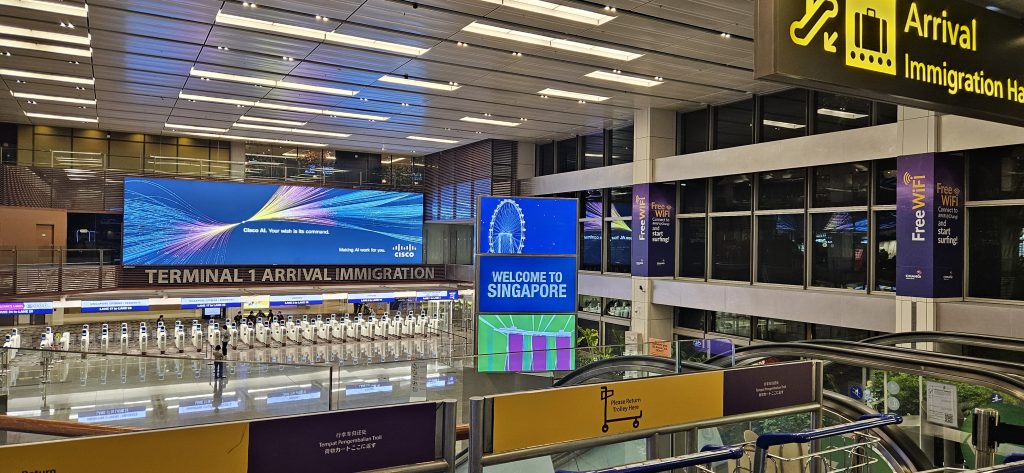
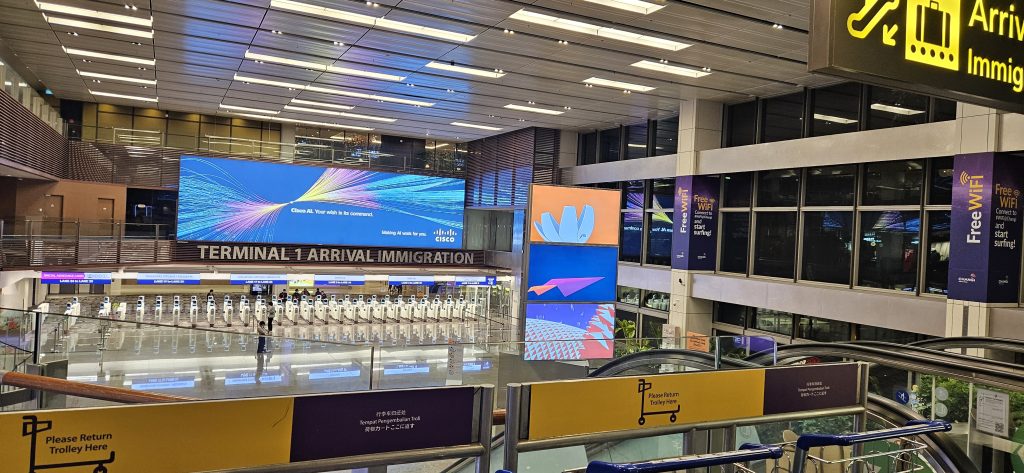 Welcome to Singapore, both images you see front and centre is the eco colonial greenwashing Internet superhighway with the right changing triptych screens all proudly featuring the iconic Marina Bay Sands Hotel, Casino, and Art Science Museum – owned by Trump‘s Sheldon Adeldson
Welcome to Singapore, both images you see front and centre is the eco colonial greenwashing Internet superhighway with the right changing triptych screens all proudly featuring the iconic Marina Bay Sands Hotel, Casino, and Art Science Museum – owned by Trump‘s Sheldon Adeldson
The hoard of interfaces for surveys to measure cleanliness or the performance of airport workers did not represent tacit empathetic exchanges. The didactics repeating to mind the step of the very zombies in transit made attempts to suck the life out of my embodied perception and soul.
On my arrival to Amsterdam, and the entire city seemed to have levelled up. The city’s canals were in the process of being rewilded, explanations provided on didactics of native species along the waters edge. This is a mammoth task while the occupants work out how to transition into a post-carbon world, and I am curious to learn more. Is such a thing possible? What is the original wild canal? What was it’s flora and fauna underwater… ? To return to a so-called ‘natural’ state, would the city centre of Amsterdam then return to a wetland…
There are many components of an ecosystem, not just one element, in the quest to resolve the place that mercantile city life has destroyed and start the extensive journey of healing the land…
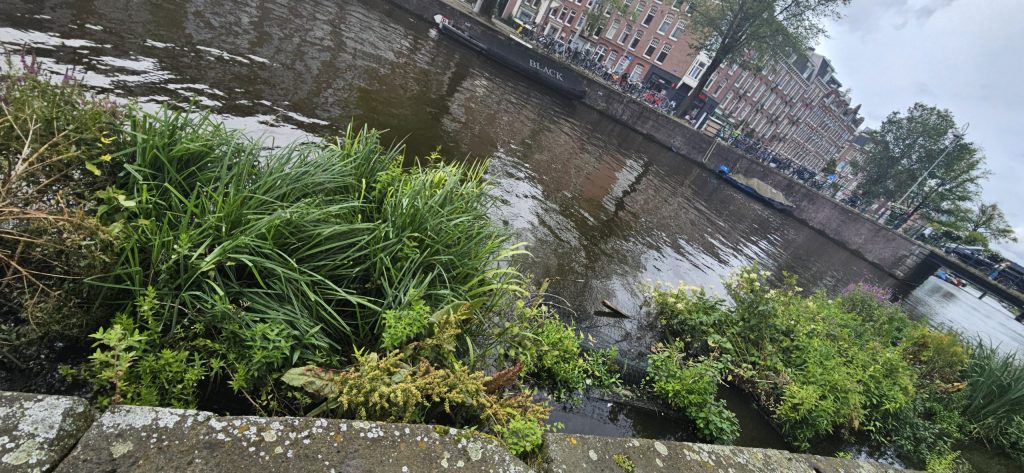
Nevertheless, I hope they find my only pair of Yves Saint Laurent glasses. From 15 years ago when I lost them on a hot day, eagerly diving into the water, elated to be floating in a boat, led me to disregard my wares. They floated away. Dear reader – if they are dredged out from the slime and you come across them, please let me know.
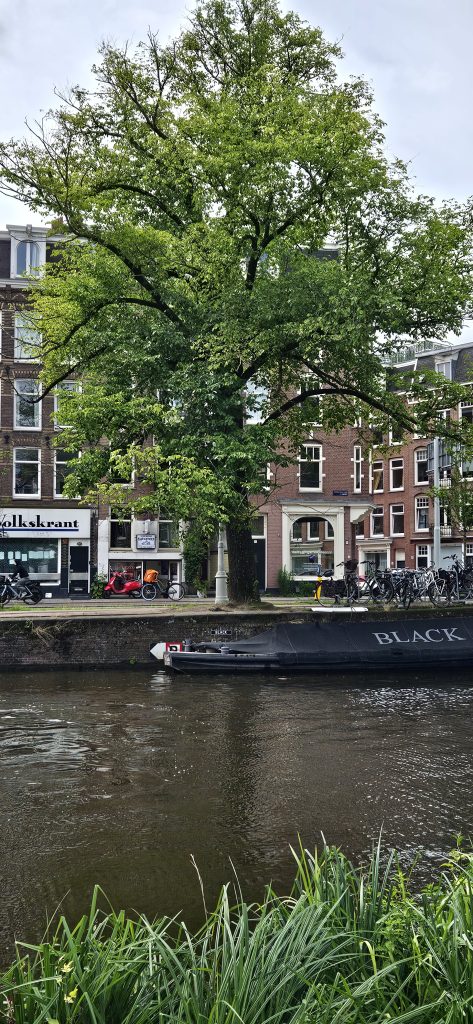
The boats in the canals in Amsterdam seem shinier and branded, dressed for a special occasion. Where there were formerly free shops and tattoo parlours, there were now tattoo removal stores.
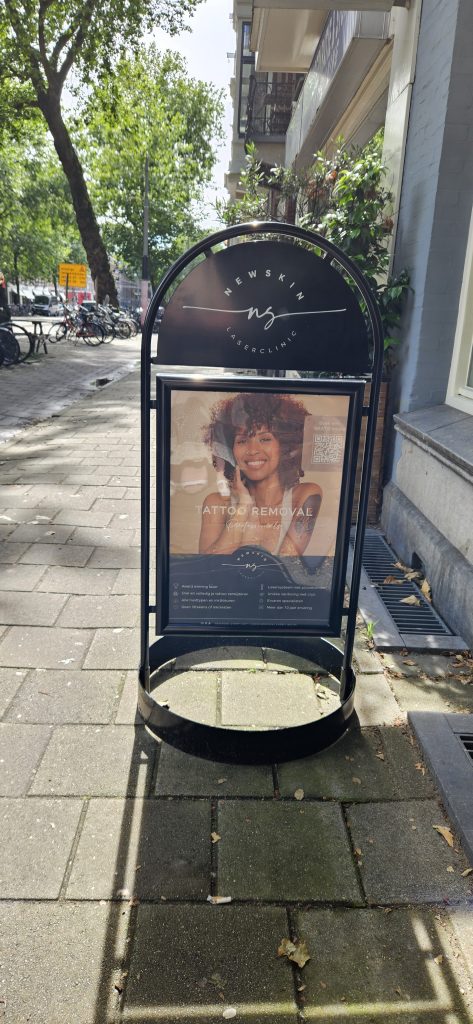
What seemed to be a bar that supported a cohort of dubious Andrew Tate look-a-likes at a glance at Cannibale Royale. Or, at least that’s the first impression I had with the trendy contemporary restaurant design of the large Knife in Chiaroscuro, amongst the black Mise-en-scène
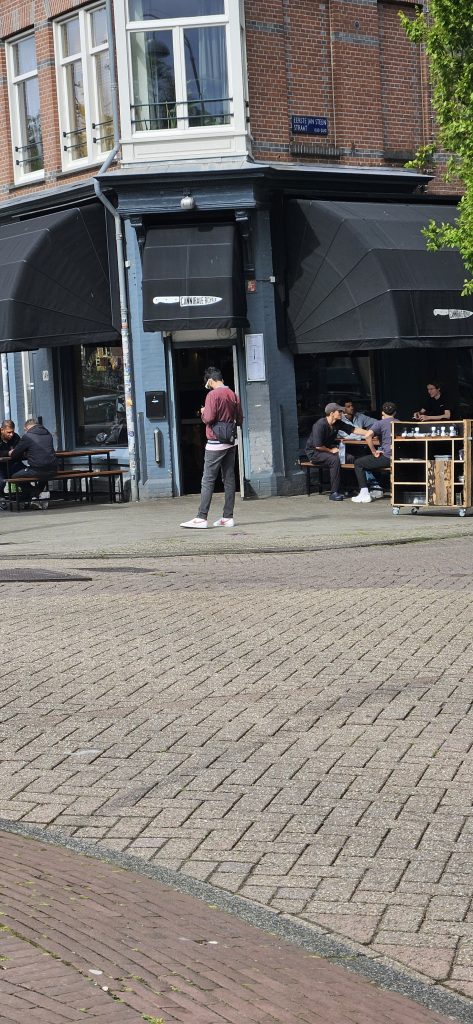
At Cannibale Royale, their story for the readers convenience. In case I am representing erroneously.
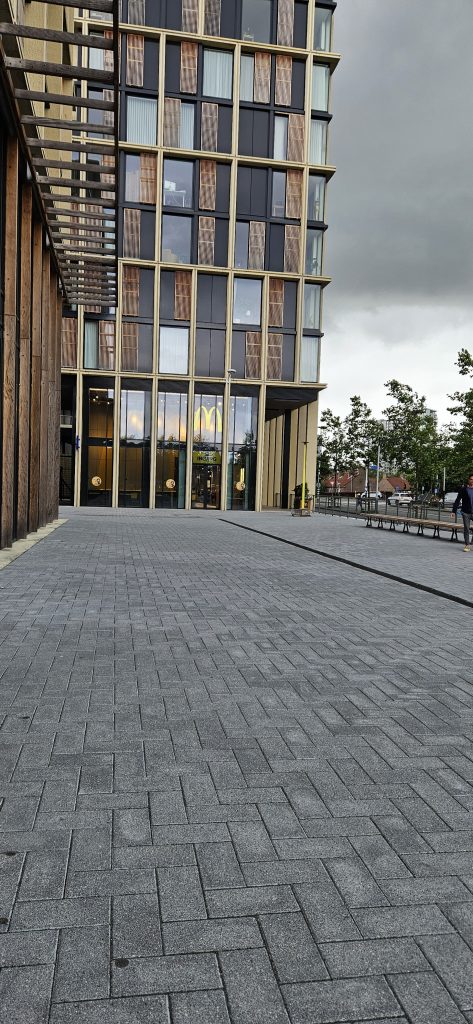
I’d never seen McDonald’s in this city, but it is now embedded in the cleanly paved design landscape
Just as there are cautionary talks about mistaking correlation for causation in data analysis. there’s a fine line between restorative ecosystems and a crisp blue Zen hell.
A system powered by unlimited desire can’t access errant energy. Most of my friends, mainly artists, have had to move to other neighbourhoods, cities, and parts of the world. Or become broedplaats bureaucrats and regularly travel to do yoga in Southeast Asia. Most can’t make it to the next leg of the Antipodes, although, thankfully, there are many exceptions.
And finally, it is the moment you have been waiting for. The behind-the-scenes of INC.

Always ahead of its time. On entering, the Blue Screen of Death met me in the ground foyer. A few days in lieu…
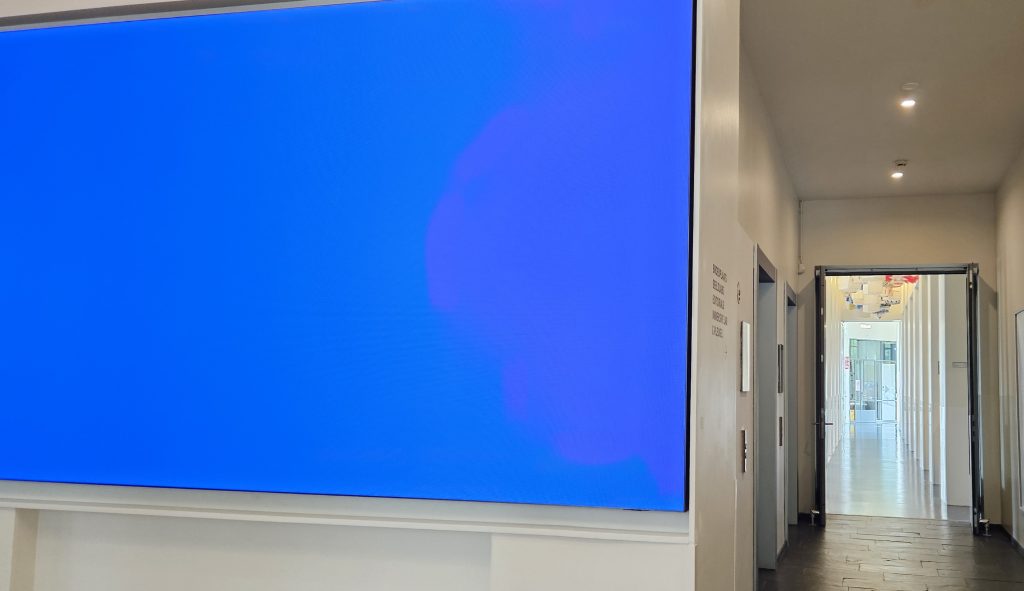
Blue Screen of Death at INC anticipating the CrowdStrike catastrophe. Or, perhaps it was also referencing the forthcoming, Platform Blues, University of Canberra Symposium.

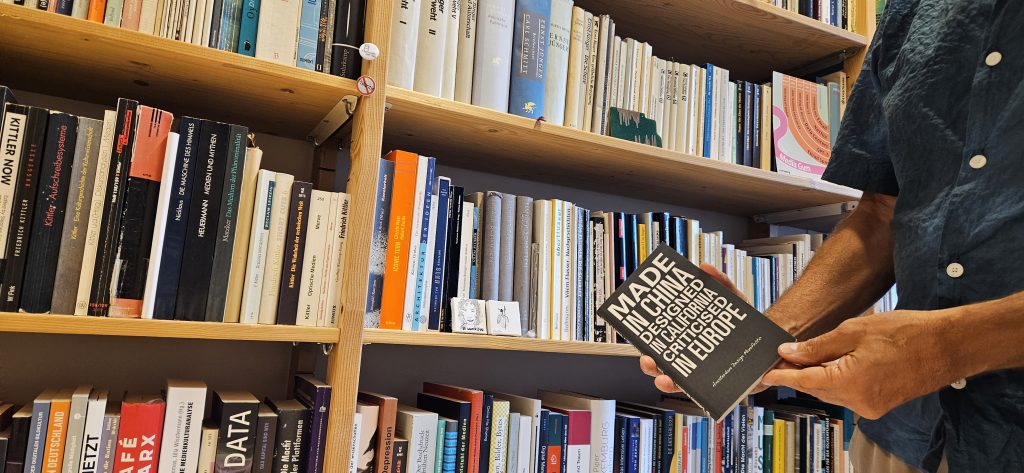
Covering variations of Zen Hell, we briefly discussed Geert’s “Principles of Perma Hybridity” written for noschool nevers printed me a hardcopy. Of which my feedback is forthcoming in the anticipation it might be noted.
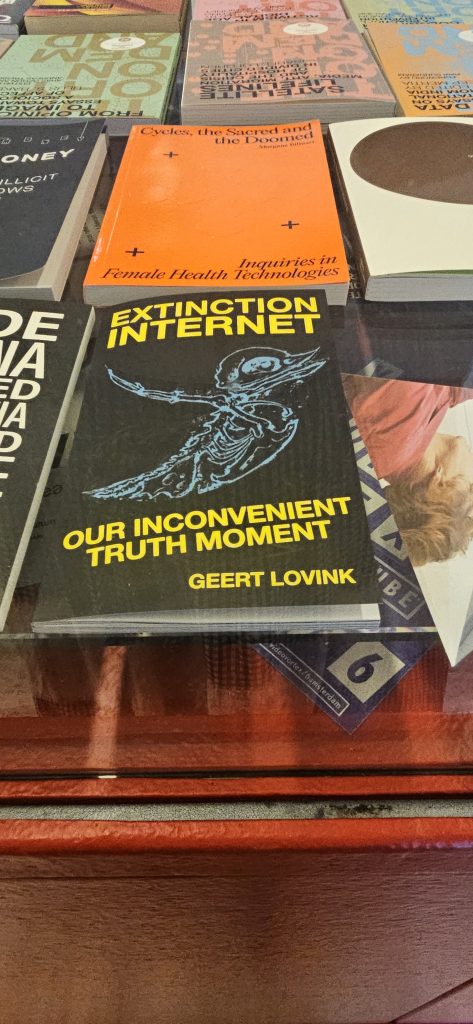
Finally arriving at Vrije University at the entrance I was met with the claim ‘English isn’t a Language it is a technology”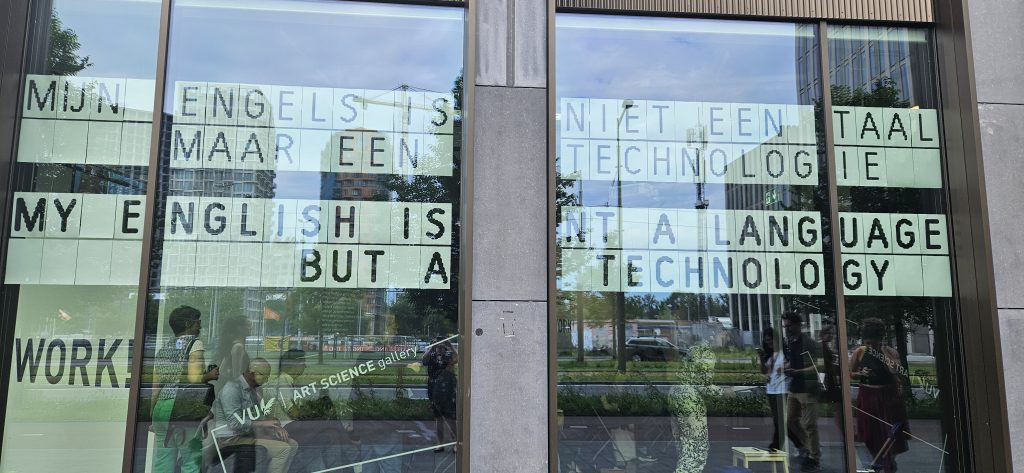
Albiet I was not convinced the University limits their computing systems and encourage permacomputing or text-based computing as a method.
The final day the symposium witnesses a constant wave of protests. 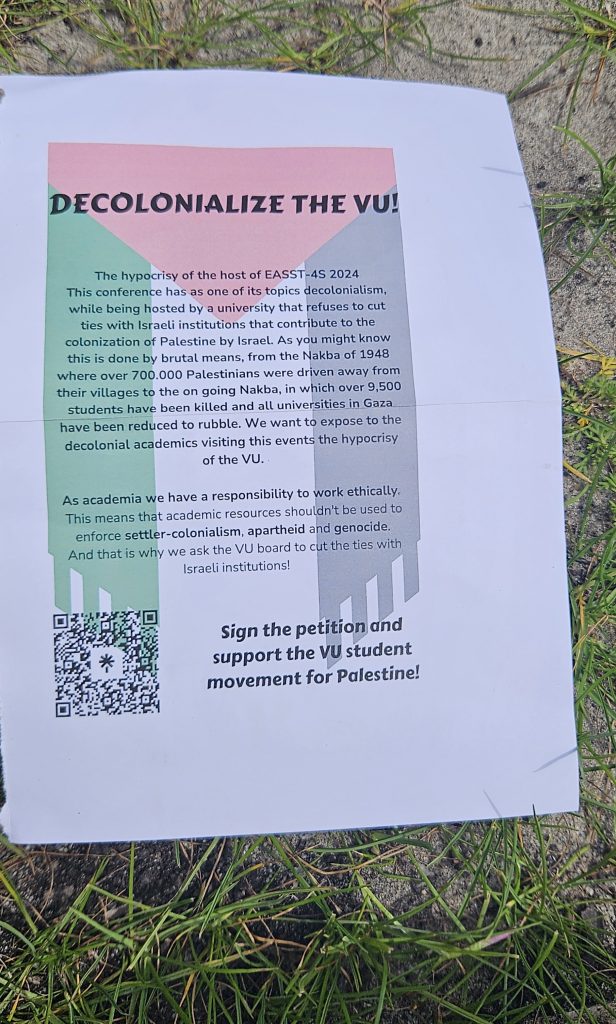
.Security was heighted and tensions proliferated throughout the multiple 15 to 20 concurrent presentations. But the timetables endured.
Eventually, these frictions, on Friday combined with the synergies of the CrowdStrike collapse from the automatic upgrade to their programs, a multi-purpose anti-malware and anti-intrusion system Falcon Sensor, released their upgrade with a severe flaw; causing a state of “kernel panic”.
As you might expect, this has caused considerable mayhem. Not only for people reliant on computational infrastructure, but the energies ricocheted socially and culturally.
One example is the fashion of Windows 10 computers to “blue screen” crash when the computers tried to restart and collapsed again, as a sartorial style. As it was with glitch a decade ago, the computer virus “Autumn/Winter 2014 collection was named after and inspired by the Blue Screen of Death”
The wave of Internet folklore memes speculating the reason for CrowdStrike also reached Tasmania, where this meme aptly mirrored the state of some of the infrastructure on the island.
This rings true as the government touts a flourishing Tasmanian economy; it faces imminent challenges in the complex decision-making processes involved in an extensive upgrade of outdated electricity and telecommunications infrastructure. Paired with the folly the Australian Government partnered with Amazon Web Services to bolster national defence and security by spending $2 billion to store top secret data announced 07 July 2024,
A strategy to secure the so-called future of innovation and security-leading protection across its infrastructure, to prevent breaches end-to-end comprehensively “from code to cloud and from device to data”
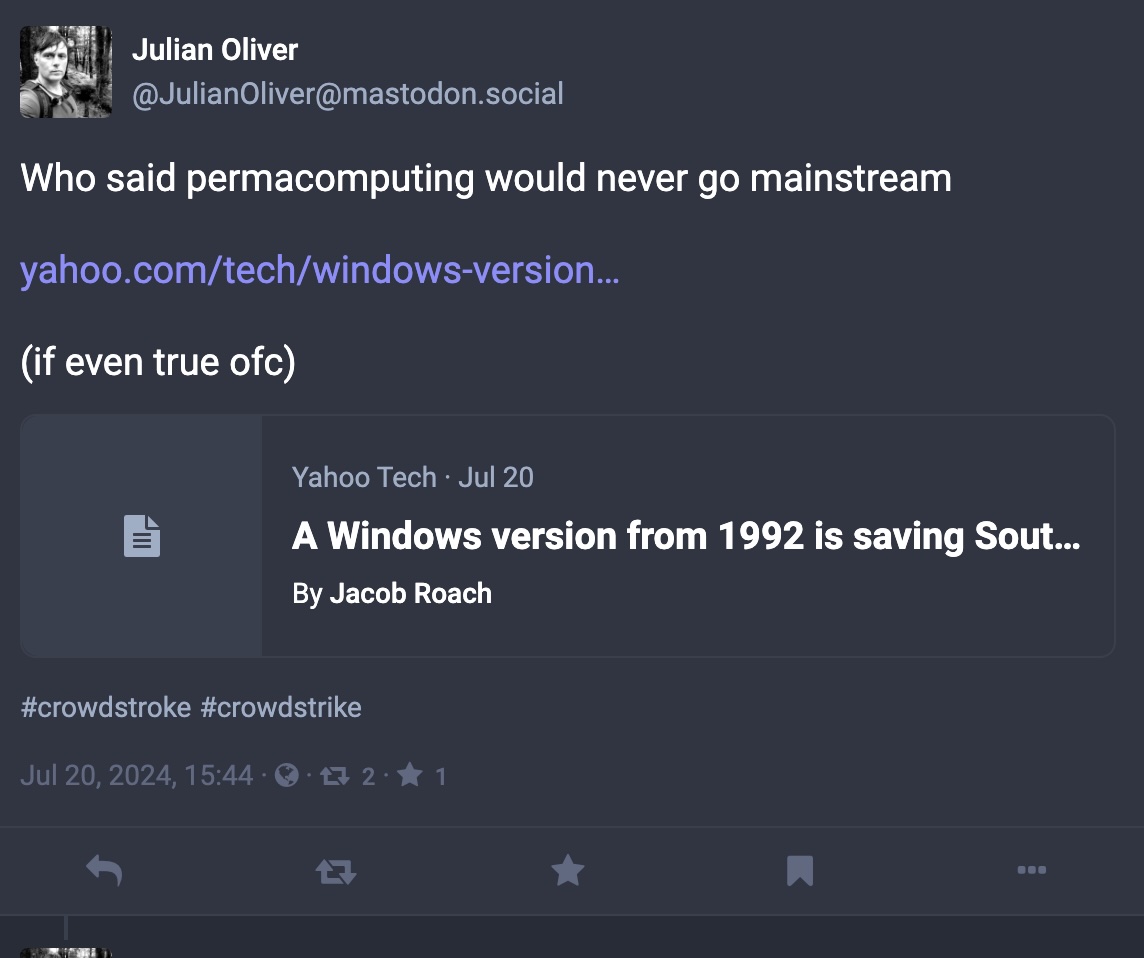
“Who said permacomputing would never go mainstream”
While the reach of computational ubiquity is vast, many compelling thoughts were expressed about the gap that this collapse had instigated as people waited for the experts to rebuild many data servers from scratch. Centralised virtual machines running on services like Amazon Web Services rely on the cloud; an outage instigated by CrowdStrike’s rippling effect, impacting airlines, public transit, and healthcare, among other sectors worldwide. Generally, there was a notable absence of any explicit reference to the ecological effect of telecommunication infrastructures, such as the carbon footprint of smartphones and data centres (largely offshore) that store people’s digital assets. Consumer digital technologies leave a significant environmental wake, yet the extractive processes of building these devices and their excessive and increasing energy consumption remain largely ignored.
You might recall some quiet yet powerful moments if you’re still with me.
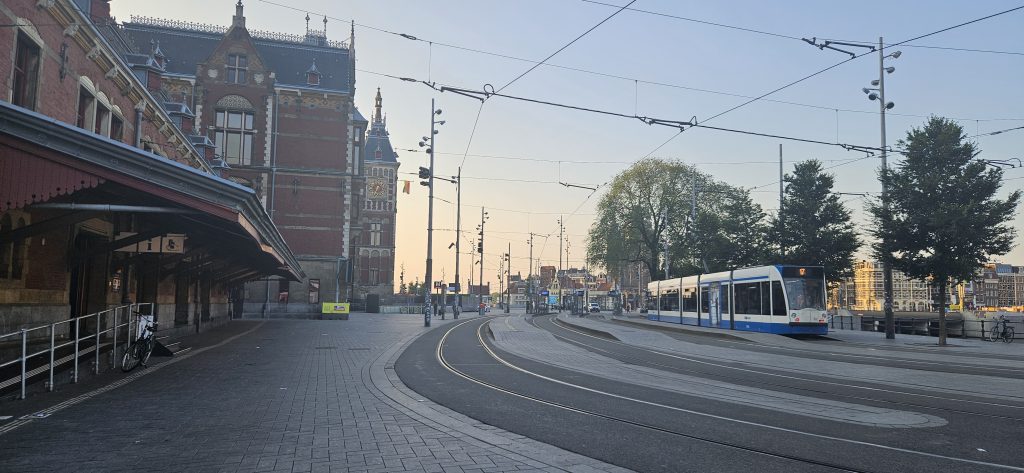
On Saturday, the screens at Amsterdam Central were still blue. I spent six hours in 30-degree heat trying to catch an earlier train to Berlin. On board, the air conditioner was kaput; much channelling of my faraway pond was divined to invigorate and keep me going.
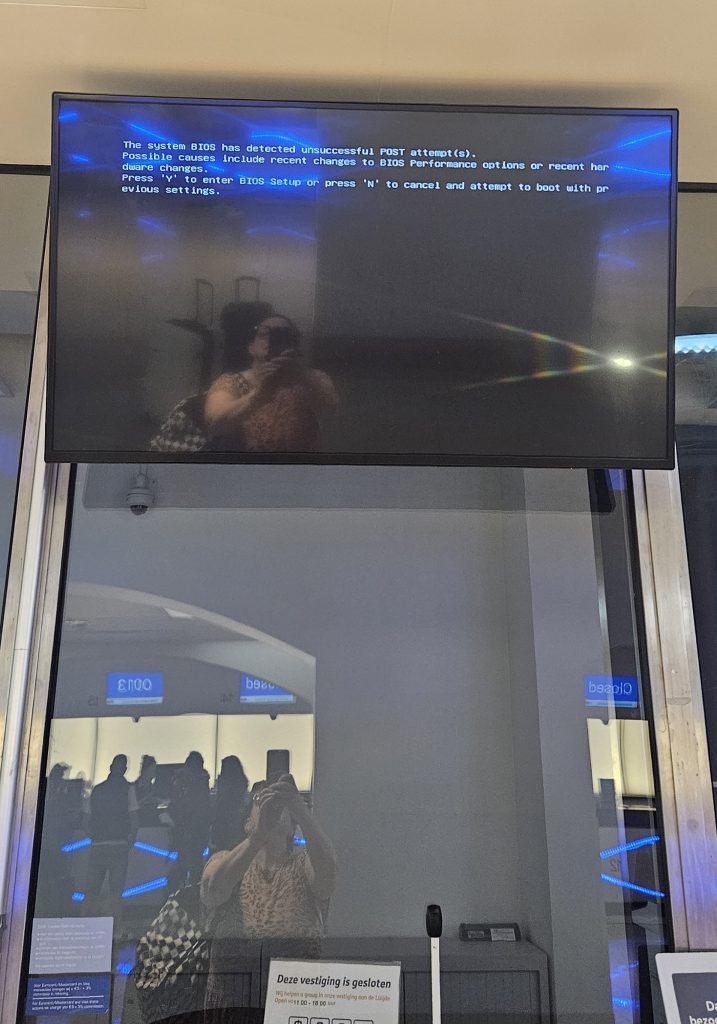
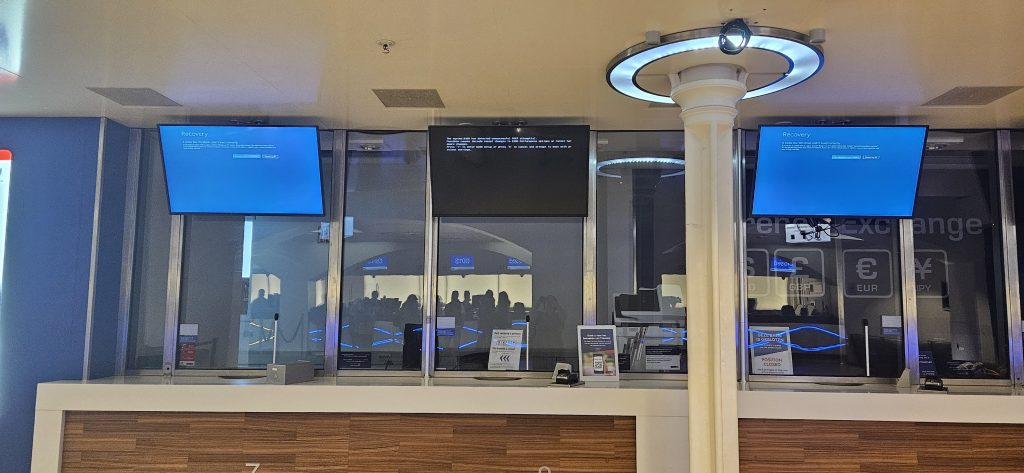
Of course, there are so many other germane aspects to cover from the scholarly artistic practice parts of this experience I didn’t cover.. It’s crucial to highlight the importance of integrating southern heritage patterns into permacomputing principles, autonomous computing arts, and the reality of a mainframe crash. These are compelling examples of why we need self-determined literacies in these areas.
The collective knowledge processes and dynamic algorithms within the permacomputing movement hold immense potential and embody the principles many of us urgently need to embrace.
What remains?
I’m left with a renewed sense of urgency to communicate the value and craft of locally driven artist led codesigned networks to a broader public.
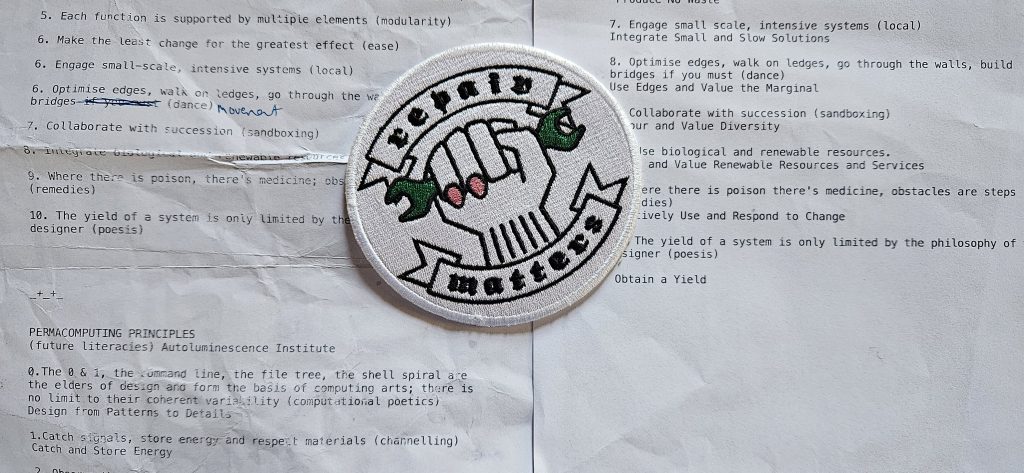
A Repair Acts patch gift from Tessa Dillon http://www.polarproduce.org/
